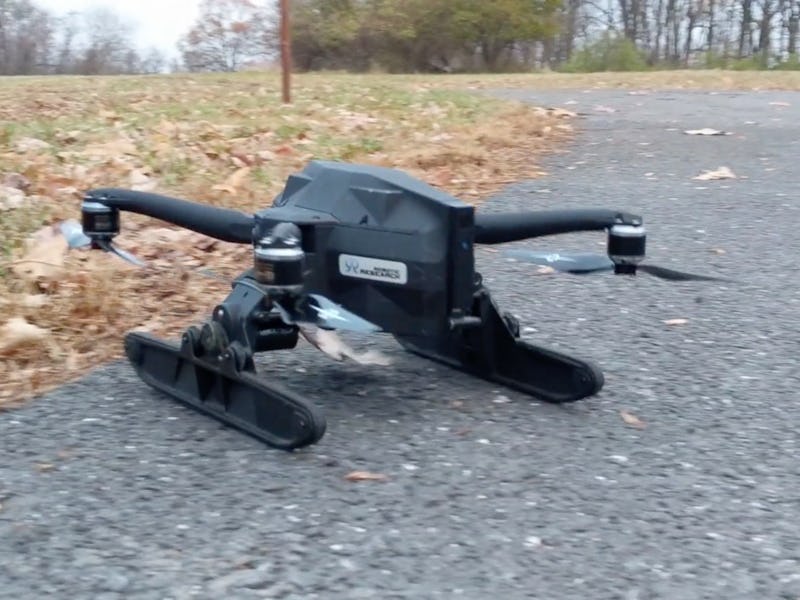The "Pegasus Mini" looks like a drone and a tank had a terrifying child
Not built for hugs, the drone offers "immense versatility."

Is it a bird? Is it a train? It’s a little bit of both, actually.
Pegasus Mini, unveiled at the Consumer Electronics Show taking place in Las Vegas this week, is a football-sized transformable drone capable of switching between its four propellors and two tank-like tracks for ground-based maneuvers.
The transforming drone, marketed toward professional uses like search-and-rescue, is designed to plug that awkward gap in some tasks where flying isn’t possible. Shooting an awesome video in the forest, but the trees are getting too thick? Developer Robotic Research shows that the Pegasus Mini’s wheels can even tackle thick layers of leaves on the ground.
“This small but mighty system has immense versatility and reach like no other robotic vehicle, flying at very high speeds with a payload capacity that can carry important tools to reach critical locations in unpredictable environments,” Alberto Lacaze, president of Robotic Research, said in a statement.
Look at it go!
Robotic Research is not the first firm to think about combining flying with driving. Indeed, the PAL-V Liberty Pioneer unveiled in March 2019 combined a helicopter and a car for transporting passengers. Airbus previously developed a concept pod back in 2017 that would carry passengers, switching between propellor and ground-based wheel modules. In the latter case, Airbus touted fast-as-possible transportation as part of its pitch. Sometimes, when getting from A to B, it’s faster to just stick to land.
Wheel-touting drones like these are unlikely to carry passengers anytime soon, but they can still offer big benefits. MIT’s CSAIL team developed a drone with wheels back in 2017, touting its ability to drive under obstacles and preserve energy by switching to wheels when possible. For the consumer market, manufacturers have produced toys like the Syma X9 that can switch between flying and driving for some fun entertainment.
The Pegasus Mini, the latest entry in this curious category, weighs 4.2 pounds and can carry up to two pounds as a payload. The whole device measures 16 inches by eight inches, resembling the size and shape of a football when folded. It’s able to operate autonomously in both air and ground, with 30 minutes in flight mode and two hours in drive mode.
The Pegasus Mini is about the same size as an American football.
The Mini employs a new depth-sensing lidar sensor developed by Velodyne, which has supplied sensors for the likes of Google in autonomous car applications. The Velabit, also unveiled at the show, is the firm’s smallest sensor. It features integrated processing in a package smaller than a deck of playing cards, range stretching up to 100 meters, and a wide field of view measuring 60 degrees horizontal and 10 degrees vertical.
The Pegasus Mini, as the name suggests, is a cut-size version of the Pegasus released in August. The family of drones are marketed for defense applications. The mid-size Pegasus II weighs 15 pounds, can be carried and operated by one person, and is marketed as a solution for surveillance and reconnaissance missions.
Pegasus II.
The full-scale Pegasus III weighs a staggering 45 pounds, supports payloads between 10 and 20 pounds, and is designed to address specialist missions.
Pegasus III.
With the full range ready to tackle a multitude of tasks, the message is clear: two wheels really are better than none.